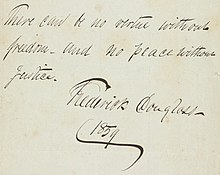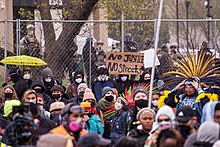 Sign at a rally following the 2016
shooting of Philando Castile | |
| Meaning | contested but either:
|
|---|---|
"No justice, no peace" is a political slogan which originated during protests against acts of ethnic violence against African Americans. Its precise meaning is contested. The slogan was used as early as 1986, following the killing of Michael Griffith by a mob of youths.
History

Linguist Ben Zimmer writes that use of the slogan "No justice, no peace" during protests goes back as far as the 1986 killing of Michael Griffith. [1] Griffith, a Trinidadian immigrant, and three friends, all black, were assaulted by a mob of white youths in the Howard Beach, Queens, New York City. Griffith fled the attackers onto a nearby highway, where he was fatally struck by a passing car. [2] In 2014, civil-rights activist Al Sharpton recounted: "In the midst of the protest, someone yelled the slogan, 'No justice, no peace'. Others began doing the same, and from then on I adopted it as a rallying cry each and every time a grave miscarriage of justice has befallen the disenfranchised." [3]
Other sources suggest that the phrase was actually popularized by activist Robert "Sonny" Carson, who is quoted on February 12, 1987 as stating, "'No justice! No peace!' [...] 'No peace for all of you who dare kill our children if they come into your neighborhood...We are going to make one long, hot summer out here...get ready for a new black in this city!," [4] while the New York Times reported on July 6, 1987: "'No justice, no peace,' said Mr. Carson repeatedly in what he said he hopes will emerge as the rallying cry for his cause." [5] Carson appears to have used the phrase conditionally . [4]
The phrase appears even earlier on a painting by Jean-Michel Basquiat, Created Equal, in 1984. [6][ non-primary source needed].
The 1992 Los Angeles riots are remembered for the use of the slogan, [7] which expressed collective frustration with the existing political order. [8]
The slogan is paraphrased in the song Baltimore by Prince.
Conditional or conjunctive
The meaning of "no justice, no peace" may change between conditional and conjunctive depending on the speaker. [1] In the conditional interpretation, the slogan is rendered as an "if-then" statement, which implies that peaceful action is impossible without justice, and which urges citizens to demonstrate against injustice even if doing so results in violence. [4] Ben Zimmer writes that during the 1980s and '90s, "'No justice, no peace' was unequivocally understood as conditional, not conjunctive", [1] such as in a 1988 statement by lawyer Ron Kuby before the U.S. House of Representatives Subcommittee on Criminal Justice:
'No Justice, No Peace' [...] summarizes the frustration and anger of New York's Black and Latino communities. 'No Justice, No Peace' remains the solemn promise of an increasing number of people in an increasingly polarized city. [1]
After the 2014 shooting of Tamir Rice, journalist Glen Ford wrote:
More than just a threat against Power, the slogan brings clarity of purpose to the participants in the movement. If the existing structures of governance and social organization cannot possibly provide justice for Black people, then those structures must be pushed aside – or there will be no civil peace. [9]
By contrast, in the conjunctive interpretation, one is stating that neither peace or justice can exist without the other. [4] After the acquittal in the Trayvon Martin murder case, the chaplain of the University of Pennsylvania said, "A lack of justice has resulted in a lack of peace", "Heavy hearts now lack peace because of the lack of justice in our nation", and "No peace because of no justice." [10] Sharpton writes, "'No justice, no peace' [...] is a way to expose inequality that would otherwise be ignored." [3]
Similar phrases

Yuvraj Joshi traces a longer history of "peace-justice claims" made by activists including Martin Luther King Jr., Bayard Rustin and A. Philip Randolph. [11] In 1967, King visited Santa Rita Jail in California, where protesters against the Vietnam War were imprisoned. There, he drew an explicit parallel between the anti-war movement and the Civil Rights Movement. Using a phrase that is explicitly conjunctive, King said, "There can be no justice without peace. And there can be no peace without justice." [4]
King had previously used the same phrase in a letter to Willem Visser 't Hooft following King's receipt of the Nobel Peace Prize, [12]: 51 and in a 1965 television appearance where he reaffirmed his call for an end to the war, stating:
There can be no peace in the world unless there's justice, and there can be no justice without peace. I think in a sense these problems are inextricably bound together. [12]: 101
During the January 1972 World Day of Peace celebrations, Pope Paul VI said, "If you want peace, work for justice." [13] [14]
Variants
...No racist police

The variant "No justice, no peace, no racist police" has been recorded in print since at least 1995. [15] This followed the murder of Joseph Gould, a homeless black man, by an off-duty white Chicago police officer, who fled the scene of the crime while Gould lay dying. [16] Related variants include "No justice, no peace, no more racist police" [17] and "No justice, no peace. Fuck these racist-ass police." [18] [19]
Know Justice, Know Peace
A homophonic variant is know justice, know peace. [20] It is used for a Dr. Martin Luther King Jr. Early College podcast, [21] the 2020 Know Justice Know Peace Resolution by the Denver Public Schools Board to better include persons of color in district school curriculums, [22] [23] and a U.S. Jesuit anti-racism retreat. [24]
No Justice, No Street

The variant "no justice, no street" or "no justice, no streets" relates to a disagreement about the fate of George Floyd Square, created in the aftermath of the murder of George Floyd in May 2020. In early August 2020, Minneapolis announced that they would reopen the intersection that the Square is located on. However, activists who maintained the barricades around the intersection demanded $156 million in various anti-racism initiatives before they would release control. [25] [26]
See also
- Hands up, don't shoot – Slogan and gesture
- I can't breathe – Human rights slogan
- Dharmo Rakshati Rakshitah – Sanskrit shloka
References
- ^ a b c d Zimmer, Ben (15 July 2013). "No justice, no peace". Language Log. Retrieved 5 June 2020.
- ^ Roberts, Sam (18 December 2011). "A Racial Attack That, Years Later, Is Still Being Felt". City Room (blog). The New York Times. Retrieved 5 June 2020.
- ^ a b Sharpton, Al (10 January 2014). "No justice, no peace: why Mark Duggan's family echoed my rallying cry". The Guardian. Retrieved 5 June 2020.
- ^ a b c d e Mazie, Steven (5 December 2014). "What Does "No Justice, No Peace" Really Mean?". Big Think. Retrieved 5 June 2020.
- ^ Popik, Barry (26 May 2005). ""No justice, no peace!"". www.barrypopik.com. Retrieved 5 June 2020.
- ^ "Created Equal: Jean-Michel Basquiat". www.wikiart.org. Retrieved 1 November 2021.
- ^ Danver, Steven L., ed. (2010). "Los Angeles Uprising (1992)". Revolts, Protests, Demonstrations, and Rebellions in American History: An Encyclopedia, Volume 3. Santa Barbara, Calif.: ABC-CLIO. p. 1097. ISBN 978-1-59884-222-7.
- ^ Levinson, David, ed. (2002). "Collective Violence". Encyclopedia of Crime and Punishment, Volume 1. SAGE Publications. p. 247. ISBN 978-0-7619-2258-2.
- ^ Ford, Glen (17 June 2015). "Tamir Rice and the Meaning of "No Justice – No Peace"". Black Agenda Report. Retrieved 5 June 2020.
- ^ Howard, Charles (14 July 2013). "No Justice, No Peace". HuffPost. Retrieved 5 June 2020.
- ^ Joshi, Yuvraj (2022). "Racial Justice and Peace". Georgetown Law Journal. 110 (5): 59. ISSN 0016-8092. SSRN 3801242.
- ^ a b Mulhall, Thomas (2014). A Lasting Prophetic Legacy: Martin Luther King Jr., the World Council of Churches, and the Global Crusade Against Racism and War. Eugene, Ore.: Wipf & Stock. ISBN 978-1-63087-342-4.
- ^ DeCosse, David E. (July 15, 2020). "'No Justice, No Peace': Catholic Connections to a Powerful Slogan". Markkula Center for Applied Ethics, Santa Clara University.
- ^ Peterson, Anna L. (June 15, 2020). "No justice, no peace: Why Catholic priests are kneeling with George Floyd protesters". The Conversation.
- ^ Popik, Barry (May 2, 2015). ""No justice, no peace, no racist police!"". www.barrypopik.com. Retrieved 5 June 2020.
- ^ Terry, Don (10 September 1995). "In Chicago, a Homeless Man Gains Currency in Death". The New York Times. Retrieved 5 June 2020.
- ^ Williams, Brad (June 3, 2020). "Shawano March, Peaceful and Well Attended". TCHDailyNews. Retrieved 15 April 2021.
- ^ Jay, Davy (4 August 2020). "Dallas' Most Prominent Police Brutality Protest Chants". Central Track. Retrieved 16 April 2021.
- ^ Thompson, Jamie (September 29, 2020). "The Armed Women at the Center of the Louisville Protests". POLITICO. Retrieved 16 April 2021.
- ^ Plaisance, Patrick Lee (2014). Media Ethics: Key Principles for Responsible Practice (2nd ed.). SAGE Publications. p. 97. ISBN 978-1-4833-2343-5.
- ^ "Denver students offer youth perspective on racial justice with new podcast "Know Justice, Know Peace"". The Denver Post. 13 July 2020. Retrieved 15 April 2021.
- ^ "Denver school board unanimously backs curriculum redesign to highlight racially diverse narratives". The Colorado Sun. 23 October 2020. Retrieved 15 April 2021.
- ^ "Student-led initiative will incorporate more Black, Indigenous and Latino voices into DPS' curriculum". Denverite. September 18, 2020. Retrieved 15 April 2021.
- ^ Flores, Angel (31 July 2020). "Know Justice, Know Peace: A Jesuit Antiracism Retreat". The Jesuit Post. Retrieved 15 April 2021.
-
^ Winter, Deena; September 22, Minnesota Reformer (22 September 2020).
"No justice, no streets: Among the powerful women who are managing George Floyd Square". Minnesota Reformer. Retrieved 15 April 2021.
{{ cite web}}: CS1 maint: numeric names: authors list ( link) - ^ Echo, The (18 February 2021). "No Justice, No Street: Protect the George Floyd Memorial". The Echo. Retrieved 15 April 2021.